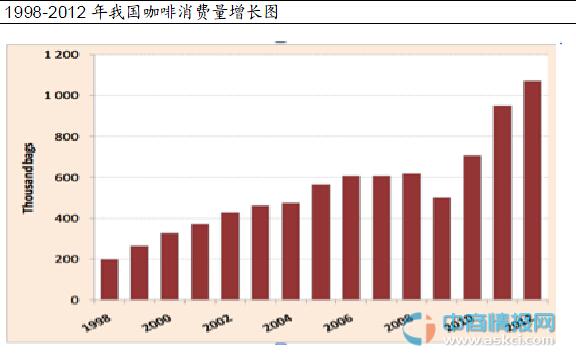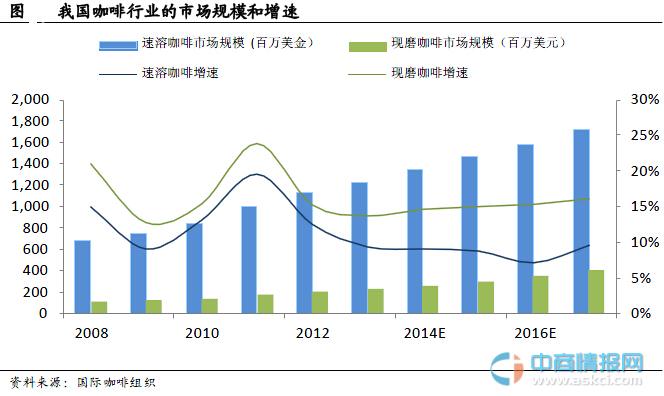Analysis of China Coffee Consumption Market in 2015
1. Changes in coffee consumption and drinking structure in China: compound growth of 13%, instant-instant-grinding
From 1998 to 2012, China's coffee consumption increased from 199000 bags to 1.1 million bags, with an annual growth rate of about 12.8%. China has a total population of about 1.3 billion, and people's coffee consumption has risen from 9.6g to 47.6g, with an average annual growth rate of about 12.1%. If the growth rate of 12.8% is maintained, China's coffee consumption will reach 2.8 million bags by 2020, and China's coffee market has great potential for development.

In terms of drinking structure, instant coffee is currently the largest segment of China's coffee consumption market, accounting for 84% of the market share. The market share of freshly ground coffee is only about 16%. However, the growth rate of the instant coffee market is not as fast as that of the freshly ground coffee market, mainly because consumers are more inclined to spend coffee beans and go to cafes due to changes in consumer habits. It is estimated that the average growth rate of instant coffee sales will drop to 8.3 percent from 2012 to 2017, and China's instant coffee consumption will reach 1.72 billion US dollars in 2015.

two。 International comparison of Coffee consumption and drinking structure
In terms of absolute quantity, coffee consumption in China is still in the doldrums. At present, the scale of the global coffee consumption market is about 12 trillion RMB. The United States is the largest coffee consumption market in the world, with an annual consumption of about 3 trillion RMB, while the coffee consumption market in China is about 70 billion RMB. However, in terms of growth rate, China's coffee consumption is growing at an annual rate of about 15%, much higher than the 2% growth rate of the global market. In terms of per capita consumption, the per capita annual consumption of coffee in China is only 0.03 kg, which is far lower than 5.6 kg in the European Union and 4.2 kg in the United States. The annual coffee consumption per capita in the world is about 1.25 kg.
At present, the average Chinese consumes only 4 cups of coffee per year, while Beijing, Shanghai, Guangzhou and other big cities consume an average of 20 cups per person per year. However, a survey by the International Coffee Organization (ICO) shows that compared with the average annual consumption of 200cups by Japanese and 140cups by Koreans in neighboring countries, China's coffee consumption market has great potential.
From the perspective of coffee drinking structure, globally, ground coffee accounts for more than 87% of the total coffee consumption, while instant coffee accounts for less than 13%. In China, instant coffee is the largest segment of the coffee consumption market, accounting for 84% of the market share. The market share of freshly ground coffee is only about 16%.
3. There is a huge space for the improvement of coffee consumption and changes in the structure of coffee consumption in China.
Based on the above analysis, we believe that although the coffee industry has experienced a period of rapid growth for nearly 10 years, it still has great growth potential in the future. We estimate that the coffee industry will ensure a growth rate of more than 10%. In addition, the change of coffee drinking structure will bring new opportunities for the development and growth of coffee industry.
The acceleration of urbanization in China is expected to lead to the growth of potential coffee consumers. The rate of drinking coffee in urban population is higher than that in rural population. Since 2007, not only first-tier cities, but also second-and third-tier cities have made great efforts to build commercial centers. Every time a commercial center is built, restaurants and cafes will naturally follow, giving a great boost to the industry.
Reason for growth 1: the market penetration of the young and middle-aged population helps to drive the growth of potential coffee consumers. As a drink with unique taste, coffee is very popular among young and middle-aged people. The survey shows that different age groups in China have different degrees of love for coffee, among which people aged 41-50 years old account for 24%, 20-30 years old account for 18%.
Reason for growth 2: the improvement of China's national income level is expected to lead to the increase of coffee consumption per capita. Coffee products are not a regular consumption necessity and strong choice preference of Chinese people, so there is a significant positive correlation between coffee consumption and residents' disposable income.
Reason for growth 3: the substitution of coffee for tea is expected to increase coffee consumption per capita. According to statistics, from 2007 to 2012, the number of teahouses in China increased from 48842 to 50984, an increase of 4%. Compared with the tepid development of teahouses, the number of cafes in China has doubled in the past five years-from 15898 in 2007 to 31783 in 2012.
Source: China Business Intelligence Network
Important Notice :
前街咖啡 FrontStreet Coffee has moved to new addredd:
FrontStreet Coffee Address: 315,Donghua East Road,GuangZhou
Tel:020 38364473
- Prev

The use of coffee for painting. Coffee leaf painting.
The use of coffee for painting is becoming more and more common, such as "hand-painting random coffee stains as http://missever.com/archives/92864.html" and "Giulia Bernardelli's coffee spill art painting http://missever.com/archives/92797.html", but Indonesian artist Ghidaq al-Nizar
- Next

Nude painting models promote new Nestle coffee products
According to the Daily Mail of July 20, Nestl é has hired a group of models to promote its newly launched coffee companion products at a coffee shop on the Lower East side of New York. In order to cater to the concept of natural and happy partners in the new product, the models took to the stage naked, wearing only painted clothes. This scene successfully attracted the attention of many customers.
Related
- What effect does Italian American coffee with filter paper have? Will coffee taste better if it is put on filter paper at the bottom of the powder bowl?
- What is the color difference in coffee beans? What are the characteristics of honey processed coffee beans? Why are the anaerobically treated coffee beans uneven in color?
- How does novice Xiaobai quickly get started and make coffee? Newbies learn to make coffee by hand and share the specific steps and process process!
- Costa tea has a shelf life of 100 years?! Expert: Unable to verify
- It's a huge uproar! American milk addition was rejected by Manner employees?!
- Mocha pot coffee bean recommendations| How fine and how much powder should be used for grinding? What parameter ratios do I need to use to make milk with Mocha pot coffee?
- What are the characteristics of the world's top ten coffee beans treated with Costa Rica honey? How to make black honey kadura from Tarazhu Pilon Processing Plant taste good?
- How to make deep-roasted coffee? What grinding water temperature does authentic Jamaica Blue Mountain No. 1 coffee use to brew it well?
- Selected high-grade rose summer coffee flavor tasting guide Why Panama rose summer has the aroma of flowers and fruits
- What equipment does a novice Xiaobai need to buy to learn to make coffee? Filter cup electronic scale bean grinder manual flushing pot purchase guide

